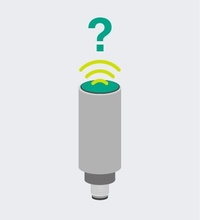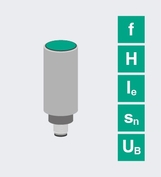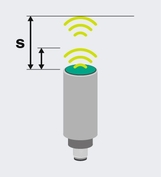Detection Method and Function

Various sensing principles can be used for different detection tasks. The sensing principle most suitable for the specific application is determined from various considerations: These include the material of the object to be detected, the application environment, and the distance from which the detection is to take place.
The use of a capacitive sensor is recommended if the object being detected is made from plastic, mineral, glass, wood, or paper, or is an oily or aqueous liquid, or a granulate or a powder, and the required detection distance is within a range of a few millimeters.
Capacitive sensors detect both metallic and non-metallic target objects. Operating distances from 1 mm ... 50 mm can be realized depending on the size and material properties of the target object, the sensor size, and the installation conditions.
The sensor type also offers a "transparent function" for detecting aqueous media or granules. In this case, the sensor responds to the content of a thin-walled and electrically nonconductive container made from material such as glass and plastic. This function is enabled by adding together the capacitive influences of the container wall and filling medium. The use of the capacitive sensor as a viewing aid allows noncontact flow and level monitoring of liquid media and bulk materials.
Special technical features of capacitive sensors:
- Detecting electrically conductive and insulating materials: ferrous metals, nonferrous metals, glass, wood, plastics, oil, water, and aqueous solutions
- Adjustable operating distance depending on object and installation characteristics
- "Transparent function" for use on thin, nonconductive container walls
Typical applications include:
- Presence monitoring of paper, wood, glass, or plastic materials
- Level control of liquid media and bulk materials (water, wastewater, pellets, tablets, granules, toner)
- Flow monitoring on plastic pipes and tubes
The excellent versatility of the physical sensing principle means that many different types of design and sensor versions are available on the market to suit specific operational conditions—such as NAMUR sensors for use in hazardous areas.
Depending on the application, the following sensing principles can be used as an alternative:
- Inductive sensor: for the exclusive detection of metallic objects.
- Magnetic field sensor: objects that are magnetic or can be equipped with a magnet.
Capacitive Sensor Design

Capacitive sensors are noncontact. The sensors detect objects located in their measurement field using the interaction of the object with the external electrical alternating field generated by the sensor.
The heart of the capacitive sensor is an electrode that generates an electrical alternating field that exits at the sensing face. The solid object or a liquid substance in the measurement field influences the electrical potential of the alternating field, or causes the capacitance to increase. This change is reported to the oscillator. The signal level in the oscillator changes. This change in the signal level is measured, compared with the internally defined threshold, and switches the output stage for binary sensors via a Schmitt trigger.
History of the Proximity Sensor
The first industrial-grade proximity sensor was developed and launched on the market in 1958 by Walter Pepperl and Wilfried Gehl. At the time, the development was driven by neighboring BASF. BASF wanted to replace the mechanical switching contacts used for detecting goods at the time with noncontact switching sensors that did not cause break sparks. The intention was to significantly reduce explosion hazards. Even the first proximity sensor was designed to be intrinsically safe in accordance with NAMUR.
Standardization
All Pepperl+Fuchs proximity sensors were, and continue to be, developed, manufactured, and marketed in accordance with the relevant standard IEC/EN 60947 "Low-voltage switchgear and controlgear—Part 5-2: Control circuit devices and switching elements—Proximity switches."
For Pepperl+Fuchs safety-related sensors, the relevant standard "Low-voltage switchgear and controlgear—Part 5-3: Control circuit devices and switching elements—Requirements for proximity devices with defined behavior under fault conditions (PDDB)" also applies.
Additional Information

Capacitive sensors have typical key technical data that must be known to ensure proper use in plants and applications.

The sensor switches at a certain distance from the reference target. This distance is referred to as the "operating distance." The operating distance is the most important characteristic of a capacitive sensor.









 +49 621 776-0
+49 621 776-0